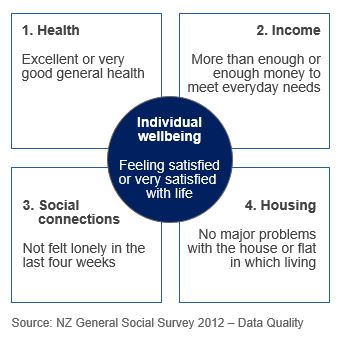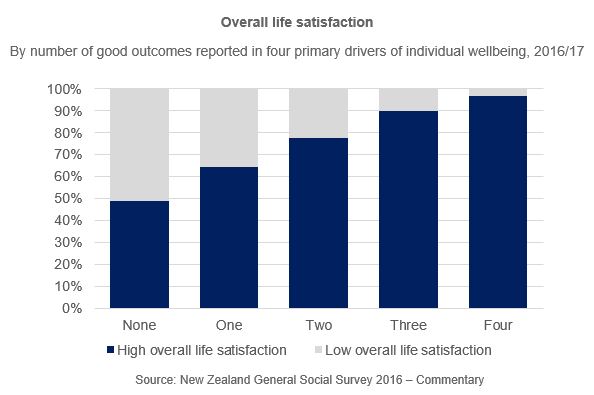Loneliness is associated with poor wellbeing
Four primary drivers of individual wellbeing
Stats NZ, as part of the General Social Survey 2012, undertook a statistical analysis of social measures to establish which are most strongly associated with wellbeing in the New Zealand population. They reported:
“A large body of international evidence shows that self-reported life satisfaction is a credible approach to measuring the well-being of a population. Given the policy interest in maximising people’s well-being, there is a need to better understand what makes people satisfied with their lives.
To inform this report, we used a logistic regression model to look at the aspects of life most strongly associated with overall life satisfaction. The advantage of using regression analysis is that it holds other factors constant, while looking at the association between the likelihood of feeling ‘satisfied’ or ‘very satisfied’ with life and the factor of interest.”
Stats NZ found that four measures in the regression model showed the strongest independent relationship with overall life satisfaction: health, income, social connections, and housing (see figure).

Stats NZ has advised us that, in this analysis, Housing had a weaker independent relationship with life satisfaction than health, income, and not feeling lonely.
Application to the data from the General Social Survey 2016
Stats NZ applied these four primary drivers of wellbeing to the data from the General Social Survey 2016. They took the life satisfaction scale, which runs from 0 and 10, and labelled those participants with a self-assessed life satisfaction of 0-6 as ‘low overall life satisfaction’ and the others with a self-assessed life satisfaction of 7-10 as ‘high overall life satisfaction’.
Each participant in the survey could have a good outcome for 0 to 4 of the four primary drivers of wellbeing. For all participants who had none of the primary drivers of wellbeing, Stats NZ looked at the proportions with low/high overall life satisfaction. They repeated this for all participants with 1, 2, 3, and finally 4 primary drivers of wellbeing. The results are shown in the figure.

Given the relationship, Stats NZ noted that the four primary drivers of wellbeing “have a strong relationship with well-being in New Zealand.” Whilst only about half of those participants with none of the four primary drivers of wellbeing had a high overall life satisfaction,
almost all (96.7%) of those participants with all four primary drivers of wellbeing had a high overall life satisfaction. As a consequence, not feeling lonely has a strong relationship with wellbeing in New Zealand.
MSD commissioned research 2019
Consistent with these findings is a recent paper, the impact of multiple disadvantage on subjective wellbeing: New Zealand families (December 2019), which found: “Health has the largest impact on life satisfaction, with both material wellbeing/incomes and social contact also having a relatively large effect. Crime/safety, poor housing, and employment all have smaller impacts, with the role of employment apparently largely mediated through its impact on incomes.” The conclusion was based on analysis of both the 2014 and 2016 NZ General Social Surveys.
